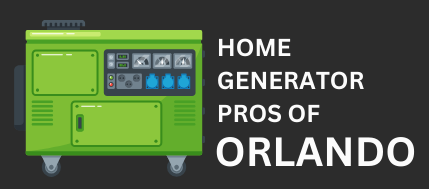
Standby Whole House Generator in Azalea Park FL
A standby whole house generator is a reliable system designed to automatically provide power to your home during an electrical outage. Unlike portable generators, which require manual setup and connection, a standby generator is permanently installed outside your home and connected to your home's electrical system. It activates automatically when the power goes out, ensuring that your home remains powered without any interruption.
What We Offer
We specialize in offering high-quality standby whole house generators in Azalea Park, FL tailored to meet your specific needs. Our range includes various models that cater to different home sizes and power requirements. We provide comprehensive services, including the selection of the right generator, professional installation, and ongoing maintenance. Our goal is to ensure that you have a seamless experience from the initial consultation to long-term support.
- Residential Generators
- Commercial Generators
- Portable Generators
- Electric Generators
- Propane Generators
- Solar Generators
- Generator Repairs
- Generator Maintenance
- Generator Parts

We will get back to you as soon as possible.
Please try again later.
How It Provides Continuous Power During Outages
A standby generator ensures continuous power during outages through an automatic transfer switch (ATS). When a power outage occurs, the ATS immediately detects the loss of power and signals the generator to start. The generator then begins supplying electricity to your home, and once the utility power is restored, the ATS switches back to the grid and shuts down the generator. This process happens seamlessly, providing you with uninterrupted power and peace of mind.
Types and Key Features to Consider
When choosing a standby whole house generator, it's essential to consider the type and key features that best fit your needs. There are two primary types: air-cooled and liquid-cooled generators. Air-cooled generators are typically more cost-effective and suitable for smaller homes, while liquid-cooled generators are designed for larger homes and offer greater efficiency and quieter operation. Key features to look for include automatic start and stop functions, remote monitoring capabilities, and durable construction.
Installation Process
The installation of a standby whole house generator involves several crucial steps. First, a site assessment is conducted to determine the optimal location for the generator. This location should be away from any potential obstructions and comply with local regulations. Next, the generator is installed and connected to your home's electrical system. An automatic transfer switch is also installed to manage the switch between the generator and the utility power. Finally, a thorough testing process ensures that everything is functioning correctly.
Maintenance and Care
To keep your standby generator running efficiently, regular maintenance is essential. This includes routine checks of the fuel system, engine, and electrical components. Scheduled maintenance services typically involve changing the oil, replacing filters, and inspecting the battery. By adhering to a maintenance schedule, you can extend the lifespan of your generator and ensure it operates smoothly when needed.
Role of ATS in Switching Power Sources
The automatic transfer switch (ATS) plays a crucial role in the operation of a standby whole house generator. It is responsible for detecting power outages and initiating the generator start-up process. The ATS also manages the switch between the generator and the utility power, ensuring that your home receives a constant supply of electricity without manual intervention. This automatic functionality is what makes standby generators a convenient and reliable choice for home power backup.
Power Output and Sizing
Choosing the right power output and size for your standby generator is vital to meet your home's needs. Generators come in various sizes, and the appropriate size depends on the number of appliances and systems you need to power during an outage. To determine the correct size, a professional assessment is conducted to evaluate your home's power requirements. This ensures that the generator you select can handle your electrical load efficiently.
Common Fuel Sources
Standby whole house generators can operate on various fuel sources, including natural gas, propane, and diesel. Natural gas is a popular choice due to its availability and convenience, as it is supplied through pipelines directly to your home. Propane is another common option, providing flexibility and a clean-burning fuel source. Diesel generators, while less common for residential use, offer high power output and durability. The choice of fuel depends on your preferences, availability, and specific needs.
Initial Investment, Ongoing Expenses, & Potential Savings
The initial investment for a standby whole house generator includes the cost of the unit, installation, and any necessary permits. Ongoing expenses involve routine maintenance and fuel costs. Despite the upfront costs, a standby generator can lead to potential savings by protecting your home from damage caused by power outages and preventing food spoilage. Additionally, having a reliable power source can contribute to increased property value and overall safety.
Benefits of Standby Whole House Generators
Standby whole house generators offer numerous benefits, including uninterrupted power during outages, convenience, and peace of mind. They automatically start and stop without manual intervention, ensuring your home remains powered regardless of the weather or other factors affecting the power grid. Additionally, they help protect your home’s appliances and systems from damage due to power surges and outages. Investing in a standby generator enhances your home’s resilience and reliability.
If you’re considering a standby whole house generator for your home in Azalea Park, FL, contact us today. Our team of experts is here to guide you through the selection, installation, and maintenance process, ensuring that you receive the best solution for your power needs. Don’t wait for the next outage to prepare—reach out to us to discuss your options and secure your home’s power reliability.
Let's Connect!
Power outages can be a real headache, especially if you're running a business from your home or have medical equipment that needs electricity to function properly. Don't get caught in the dark and without power. That's where Home Generator Pros of Orlando comes in. Our team of certified professionals will take care of all your home generator needs, from installation to maintenance and repairs. Don't wait until the next power outage to realize the importance of having a reliable backup generator. Call us today to schedule your consultation and get your home prepared for anything.